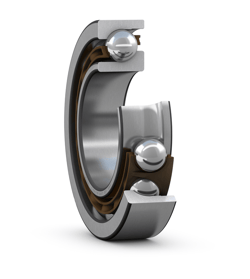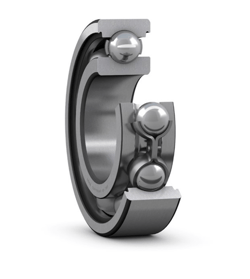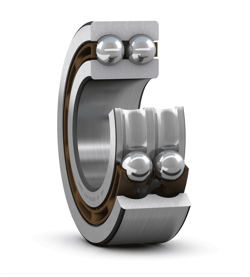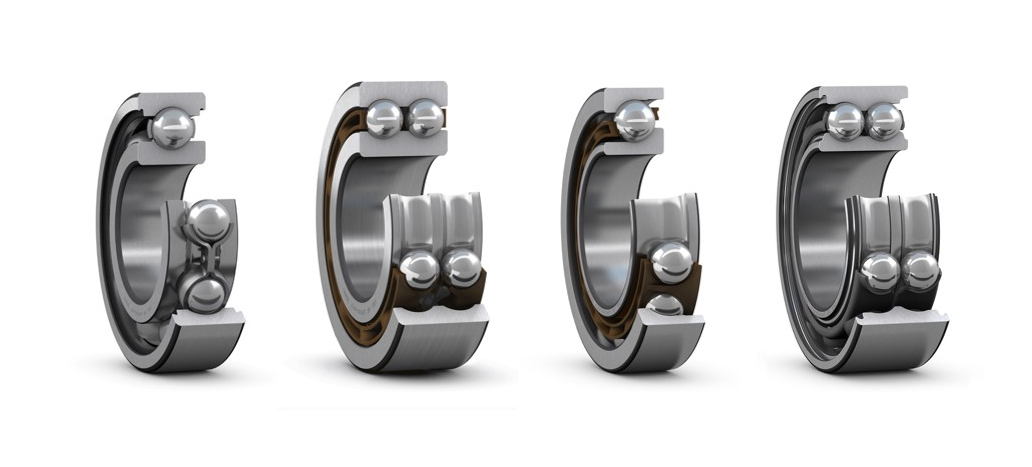A ball bearings is a rolling-element bearing that relies on balls to keep the bearing races apart. A ball bearing's job is to decrease rotational friction while also supporting radial and axial stresses. Ball bearings have been around for hundreds of years and have been utilized in various applications — intended to accommodate thrust and radial stresses in everything from hard drives to skateboards. On the other hand, ball bearings are also often used in situations with lower pressures.
Load is transferred from the outer race of the ball to the inner race. Everything may spin smoothly because the ball's spherical form only makes minor contact with the inner and outer races. However, if the bearing is not used appropriately, it might become an impediment. If the bearing is overworked, the balls may distort and damage the bearing due to the narrow area of contact sustaining the load.
Ball bearings are typically made from chrome steel or stainless steel. Surprisingly, glass or plastic balls also have use cases in certain consumer applications. They are also available in a variety of sizes, ranging from miniature bearings for hand tools to large bearings for industrial machinery. Their load capacity and their reliability usually rate Ball-bearing units.
When selecting a ball bearings, it is essential to consider the operating conditions and the required level of reliability.
Two Types of Ball Bearings
Single row ball bearing and double row ball bearing are the two main types of ball bearing units. Single row ball bearings have one row of balls and are suitable for applications where radial and axial loads are relatively low. Double row ball bearings have two rows and are used in applications where higher loads are expected or where higher levels of reliability are required.
Single Row Ball Bearings
1. Single Row Angular Contact Ball Bearings
 (Source: SKF)
(Source: SKF)
These bearings can only support axial loads in one direction, often adjusted against a second bearing with non-separable rings. They include a large number of balls to give them a relatively high load-carrying capacity.
Advantages of single row angular contact ball bearings:
- High load-carrying capacity
- Good running properties
- Easy mounting of universally matched bearings
2. Single Row Deep Groove Ball Bearings
 (Source: SKF)
(Source: SKF)
The most common form of ball bearing is a single-row deep groove ball bearing. Their usage is quite common. The inner and outer ring raceway grooves contain circular arcs that are somewhat bigger than the radius of the balls. In addition to radial loads, axial loads can be applied in either direction. They are well suited for applications requiring fast speeds and minimum power loss because of their low torque.
Applications of Single Row Ball Bearings:
- Medical diagnostic equipment, flow meters and anemometers
- Optical encoders, electrical motors, and dental hand tools
- Power hand tool industry, industrial blowers, and thermal imaging cameras
Double Row Ball Bearings
1. Double Row Angular Contact Ball Bearings
 (Source: SKF)
(Source: SKF)
They can support radial and axial loads in either direction and tilting moments, with a design comparable to two single row bearings put back-to-back. Two single bearings often take up too much axial space.
Advantages of a double row angular contact ball bearing:
- Less axial space allows for radial as well as axial loads to be accommodated in either direction.
- Bearing arrangement with a lot of tension
- Allows for tilting moments
2. Double Row Deep Groove Ball Bearings
 (Source: SKF)
(Source: SKF)
In terms of design, double row deep groove ball bearings are similar to single row deep groove ball bearings. Their deep, unbroken raceway grooves are closely osculated with the balls, allowing the bearings to support radial and axial stresses. These ball bearings are ideal for bearing systems when a single row bearing's load-carrying capability is insufficient. Double row bearings in the 62 and 63 series are somewhat broader than single row bearings in the same bore. Deep groove ball bearings with two rows are only available as open bearings.
Applications of double row ball bearings:
- Gearboxes
- Rolling mills
- Hoisting equipment
- Machines in the mining industry, e.g., tunneling machines
Main Differences Between Double and Single Row Ball Bearings
Single row ball bearing are the most common type of ball bearing. This bearing has one row of rolling parts, with a simplistic construction. They are non-separable, appropriate for high speeds, and durable in operation. They can handle both radial and axial loads.
Double row ball bearing are more robust than single row and can handle higher loads. This type of bearing can take radial loads and axial loads in both directions. It can keep the shaft and housing axial movement within the bearing's axial clearance. However, they are also more complex in design and require more precise manufacturing tolerances.
Conclusion
Both single row and double row ball bearing are widely used in various applications. Single row are commonly used in light-duty applications, while double row are more suitable for heavy-duty applications. Ball bearings are essential components in many types of machinery and equipment.
To ensure proper bearing functioning. All ball bearings must endure a minimum load, especially at high speeds or strong accelerations or when the load direction changes rapidly. The inertial force of the ball and the cage and friction in the lubricant will adversely influence the bearing's rolling, and a sliding motion between the ball and the raceway may occur, potentially damaging the bearing.
Check out below blog to find out why are ball bearings are used in machines:
https://blog.slsbearings.com/why-are-ball-bearings-used-in-machines
Being a ball bearings Singapore supplier, SLS provides consultation on the types of ball bearings you may need for your manufacturing services. With more than five decades of experience under our belt, we are certain that the best type of bearings is assigned to your specific industrial use. Contact us now at contact.us@slsbearings.com.sg







